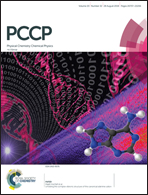A progressive metal–semiconductor transition in two-faced Janus monolayer transition-metal chalcogenides†
Abstract
Breaking the symmetry in the out-of-plane direction in two-dimensional materials to trigger distinctive electronic properties has long been predicted. Inspired by the recent progress in the experimental synthesis of a sandwiched S–Mo–Se structure (Janus SMoSe) at the monolayer limit [Zhang et al., ACS Nano, 2017, 11, 8192–8198], we investigate the transport and electronic structure of two-faced XMoY monolayers (X, Y = O, S, Se and Te) through first-principles calculations. It is found that all the monolayers are semiconductors except OMoTe, which is metallic. Interestingly, the “parents” of OMoTe (MoO2 and MoTe2) are both semiconductors. Further analysis shows that it is the out-of-plane asymmetry-induced strain that results in the metal–semiconductor transition between Janus OMoTe and its parents. By increasing the ratio of O atoms in one face of MoTe2, a progressive decreasing trend of the bandgap, as well as the transition to metallic, is found. In addition, a transition from the direct band gap semiconductor to the indirect one is also observed in the process. This could be used as an effective way to precisely control electronic structures, e.g., the bandgap. Different from other methods, this method uses the intrinsic features of the material, which can persist without the need of additional equipment. Moreover, such a modulating method is expected to be extended to many other transition-metal chalcogenides, showing great application potential.



 Please wait while we load your content...
Please wait while we load your content...